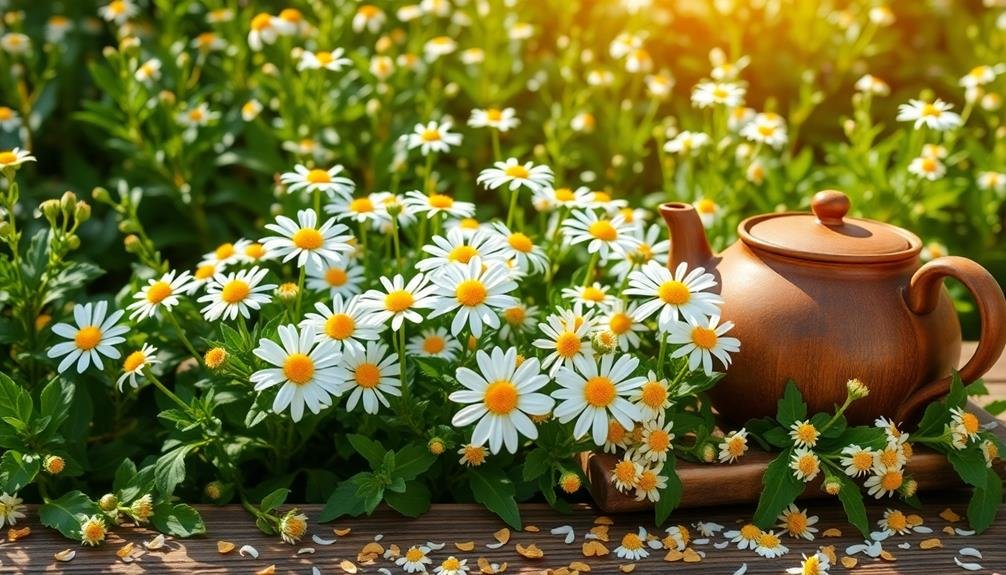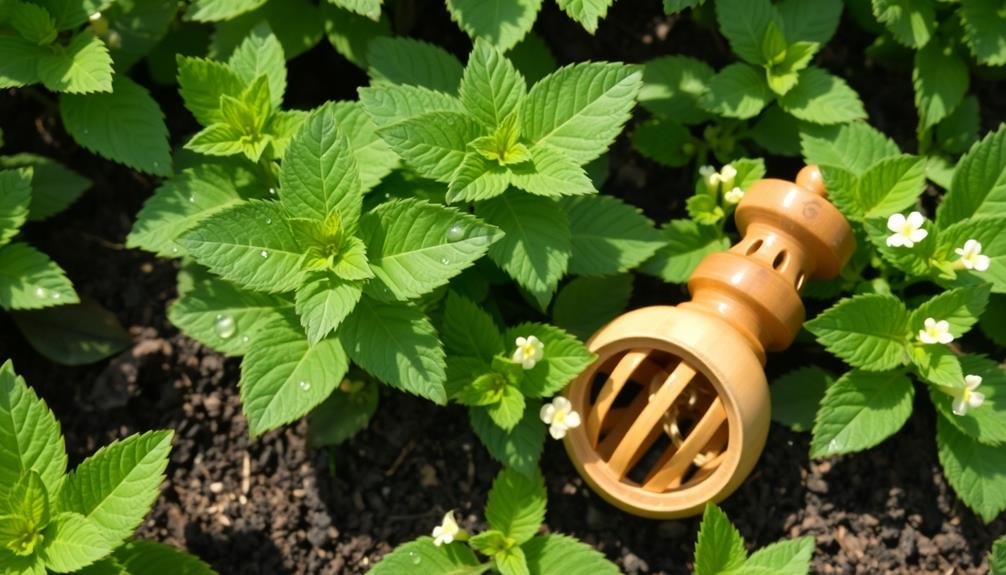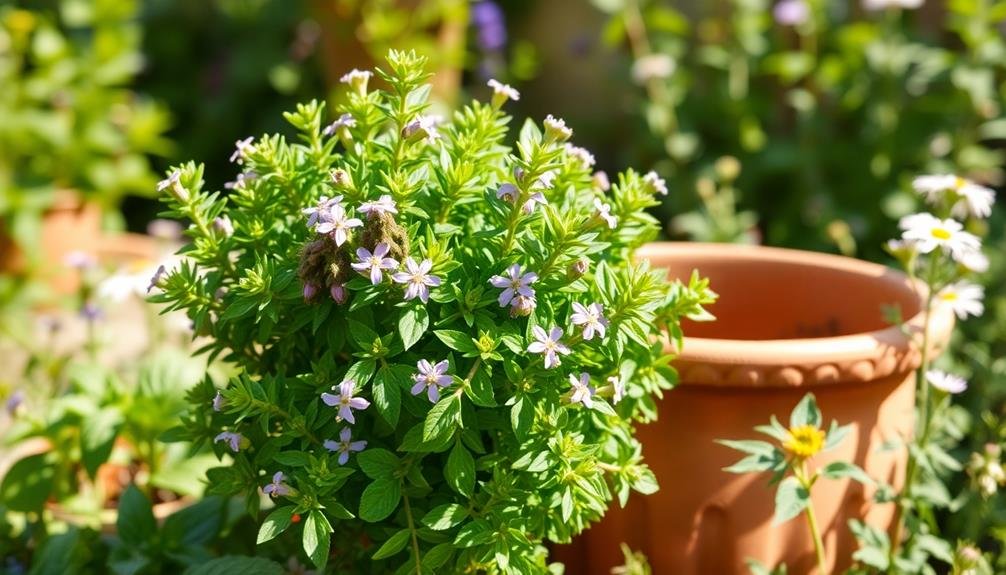To elevate your homemade tea, grow these 10 essential herbs: chamomile for relaxation, peppermint for invigorating flavor, and lemon balm for its calming properties. Lavender adds a floral touch, while ginger provides a spicy kick. Sage soothes digestion, and rooibos offers a caffeine-free option rich in antioxidants. Don't forget thyme, which boasts multiple health benefits, and basil, perfect for a fresh twist. Each herb thrives in sunny spots, requires minimal care, and can greatly enhance your tea experience. You might be surprised by the unique blends you can create from these herbs!
Chamomile

Chamomile is one of the most popular herbs for homemade tea, and for good reason. This gentle flower offers a plethora of benefits that make it a favorite among tea lovers.
When you brew chamomile tea, you're in for a soothing experience that can help you unwind after a long day. Its natural calming properties can ease stress and promote better sleep, making it an excellent choice for those restless nights.
To enjoy chamomile tea, you can use dried chamomile flowers or grow your own plants. If you opt to grow them, you'll find they're easy to care for and thrive in sunny spots.
Once harvested, you can dry the flowers and store them for later use. When you're ready for a cup, steep about 1-2 teaspoons of dried flowers in hot water for about five minutes.
You'll notice the sweet, apple-like aroma and flavor that chamomile is known for. For a delightful twist, consider adding a touch of honey or lemon.
Enjoy your chamomile tea not just as a beverage, but as a delightful ritual that nurtures your mind and body.
Peppermint
When it comes to revitalizing herbal teas, peppermint stands out as a favorite for many. Its invigorating aroma and flavor make it a perfect choice for a rejuvenating brew. You'll love how easy it is to grow peppermint in your garden or even in pots on your patio.
Peppermint isn't just about taste; it offers numerous health benefits too. It can help soothe digestive discomfort and even relieve headaches. Plus, its delightful scent can uplift your mood and enhance your focus.
Here's a quick overview of peppermint's key features:
| Feature | Description | Benefits |
|---|---|---|
| Flavor | Fresh, cool, and minty | Rejuvenating taste |
| Growing Conditions | Full sun to partial shade | Easy to cultivate |
| Harvesting | Cut leaves regularly | Encourages new growth |
| Uses | Teas, desserts, cocktails | Versatile in recipes |
| Health Benefits | Digestive aid, headache relief | Natural remedy |
Lemon Balm

Although you mightn't hear about lemon balm as often as other herbs, it's a fantastic addition to your homemade tea collection. This versatile herb, known for its delightful lemony scent, is easy to grow and thrives in various conditions. You can plant it in your garden or in pots on your balcony. Just make sure it gets plenty of sunlight and water, and you'll be rewarded with lush, aromatic leaves.
When you're ready to brew, simply harvest a handful of fresh lemon balm leaves. Rinse them lightly, then steep them in hot water for about 5 to 10 minutes. The result is a soothing tea that not only tastes invigorating but also comes with numerous health benefits.
Lemon balm is known for its calming properties, making it a perfect choice for unwinding after a long day. You can enjoy it on its own or blend it with other herbs, like chamomile or hibiscus, for a unique flavor profile.
Lavender
Have you ever considered the calming effects of lavender tea? This delightful herbal infusion not only soothes your nerves but also offers a unique flavor profile that can elevate your tea-drinking experience.
Lavender is easy to grow in your garden or even in pots, making it a perfect choice for home gardeners.
When you brew lavender tea, you'll notice its beautiful floral aroma filling the air, instantly promoting relaxation. It's known for its ability to reduce stress and anxiety, helping you unwind after a long day. Plus, it may assist with sleep, creating a calming bedtime ritual.
To make lavender tea, simply steep a teaspoon of dried lavender buds in hot water for about 5-10 minutes. Feel free to add honey or lemon to enhance its flavor. You can also blend it with other herbs like chamomile or mint for a more complex taste.
Growing lavender is straightforward; it thrives in well-drained soil and sunny spots. With minimal care, you'll have a steady supply of fresh lavender for your tea.
Ginger

Ginger tea is a spicy and invigorating drink that packs a punch with its warm flavor and numerous health benefits.
Growing your own ginger can be incredibly rewarding, and it's surprisingly easy! With just a little effort, you can enjoy fresh ginger for your teas and other recipes.
Here are three reasons why you should consider growing ginger:
- Health Benefits: Ginger is known for its anti-inflammatory properties and can help soothe digestive issues, reduce nausea, and boost your immune system.
- Versatility: You can use fresh ginger in various dishes, not just teas. It adds a zesty kick to stir-fries, soups, and even baked goods.
- Easy to Grow: Ginger thrives in warm, humid conditions. Just plant a piece of ginger root in well-drained soil, keep it moist, and watch it flourish in a sunny spot.
Hibiscus
Hibiscus tea offers a vibrant, tart flavor that's both invigorating and packed with health benefits. When you grow hibiscus in your garden, you're not just adding a stunning splash of color; you're also cultivating a tea that's rich in antioxidants and vitamins. It can help lower blood pressure, improve digestion, and support liver health. Plus, it's naturally caffeine-free, making it an excellent choice for any time of day.
Here's a quick comparison of hibiscus tea benefits versus traditional black tea:
| Hibiscus Tea | Black Tea |
|---|---|
| High in antioxidants | Moderate antioxidants |
| Lowers blood pressure | Can raise blood pressure |
| Caffeine-free | Contains caffeine |
When you steep hibiscus flowers, you'll be greeted with a beautiful deep red infusion that's as pleasing to the eye as it is to the palate. You can enjoy it hot or cold, and it pairs wonderfully with other herbs and fruits. So, consider adding hibiscus to your garden; it'll not only enhance your tea collection but also support your wellness journey.
Rooibos

Rooibos is more than just a delicious herbal tea; it offers a range of health benefits that you might find intriguing.
If you're considering growing it yourself, you'll need to understand the specific conditions it thrives in.
Plus, I'll share some handy tips for harvesting and using this unique plant.
Health Benefits of Rooibos
If you're looking for a caffeine-free alternative that also packs a punch of health benefits, rooibos tea might just be your new go-to. This South African herbal tea isn't just delicious; it's loaded with nutrients that can boost your health in several ways.
Here are three key benefits of rooibos tea:
- Rich in Antioxidants: Rooibos contains powerful antioxidants like aspalathin and nothofagin, which help combat oxidative stress and reduce inflammation in your body.
- Supports Heart Health: Studies suggest that rooibos tea can help improve heart health by lowering blood pressure and cholesterol levels, making it a great addition to your daily routine.
- Aids Digestion: Drinking rooibos tea may help alleviate digestive issues. It's naturally caffeine-free and has antispasmodic properties that can soothe your stomach.
Incorporating rooibos tea into your diet is an easy way to enjoy these health benefits.
Whether you drink it hot or iced, you'll find it's a delightful and nutritious choice for any time of day.
Growing Conditions Required
To enjoy the full benefits of rooibos tea, it's important to understand the growing conditions required for this unique plant. Rooibos thrives in well-draining, sandy soils with a slightly acidic to neutral pH level. Aim for a soil pH between 5.5 and 7.0 to guarantee ideal growth.
When selecting a location, choose a sunny spot that receives at least six to eight hours of sunlight daily.
Rooibos is drought-tolerant, so it doesn't need too much water. However, regular watering during dry spells helps promote healthy growth. Be careful not to overwater, as this can lead to root rot.
If you're in a cooler climate, consider growing your rooibos in pots that can be moved indoors during harsh weather.
Temperature plays a key role, too. Rooibos prefers warm climates, ideally between 25-30°C (77-86°F). If you're starting from seeds, germination can take a few weeks, so be patient.
Once established, rooibos can be a hardy addition to your garden. With the right conditions, you'll soon enjoy your homegrown rooibos tea, packed with flavor and health benefits.
Harvesting and Usage Tips
When it comes to harvesting rooibos, timing is essential for achieving the best flavor and quality. You'll want to harvest your rooibos when the stems are a rich reddish-brown color and the leaves have a sweet aroma. Typically, this happens around 18 months after planting.
Here are some key tips for harvesting and using rooibos:
- Cutting: Use sharp garden shears to cut the stems about 2-3 inches above ground level. This helps promote new growth for future harvests.
- Drying: After cutting, spread the rooibos leaves out in a single layer in a shaded, well-ventilated area. Allow them to dry for about 5-7 days until they're crisp to the touch.
- Storing: Once dried, store your rooibos in an airtight container away from light and moisture. This preserves its flavor for months.
Now you're ready to brew! Steep the dried leaves in hot water for about 5-7 minutes, and enjoy a delicious cup of homemade rooibos tea.
Sage
Sage, often revered for its robust flavor and aromatic qualities, makes a delightful addition to your homemade teas. Its earthy, slightly peppery taste can elevate your brews, offering a unique experience. When you grow sage, you'll find it's not just easy to cultivate but also versatile in its uses.
To help you understand its benefits, here's a quick overview:
| Benefit | Description | Usage in Tea |
|---|---|---|
| Antioxidants | Rich in compounds that combat free radicals | Supports overall health |
| Digestive Aid | Known to soothe digestive issues | Great for after meals |
| Anti-inflammatory | Reduces inflammation in the body | Helps with sore throats |
| Aromatic Properties | Provides a calming scent | Enhances tea's fragrance |
Simply steep fresh or dried sage leaves in hot water for about 5 to 10 minutes. You can combine it with other herbs like mint or chamomile for a delightful blend. Remember, sage is strong, so adjust the quantity to suit your taste. Enjoy experimenting and savoring the unique flavors of your homemade sage tea!
Thyme

Thyme is more than just a flavorful herb; it offers a range of health benefits you won't want to miss.
If you're considering growing thyme yourself, there are some tips that can help you succeed.
Plus, you can whip up some delicious thyme tea recipes to enjoy its unique taste and wellness properties.
Health Benefits of Thyme
One teaspoon of thyme can offer a wealth of health benefits that you mightn't expect from such a small herb. This versatile herb isn't just a flavorful addition to your meals; it also packs a powerful punch regarding wellness.
Here are three key benefits you should know:
- Rich in Antioxidants: Thyme contains compounds like thymol and carvacrol, which help combat oxidative stress in your body. This can lead to improved overall health and reduced risk of chronic diseases.
- Supports Respiratory Health: Thyme has natural antiseptic properties that can help soothe coughs and bronchitis. Drinking thyme tea may clear congestion and promote easier breathing.
- Boosts Immunity: The antimicrobial properties of thyme can fend off illnesses. Regular consumption can strengthen your immune system, making it easier for your body to fight off infections.
Incorporating thyme into your homemade tea not only enhances flavor but also contributes to your health.
Growing Thyme Successfully
To successfully grow thyme in your garden or pots, it is essential to understand its preferences and needs. This aromatic herb thrives in well-drained soil and loves full sunlight, so pick a location that gets at least six hours of direct light each day. Water thyme sparingly; it prefers drier conditions, which helps prevent root rot.
Here's a quick reference table to help you grow thyme successfully:
| Aspect | Preference | Tips |
|---|---|---|
| Soil Type | Well-drained | Use sandy or loamy soil |
| Light Requirement | Full sun (6+ hours) | Choose a sunny spot |
| Watering | Low moisture | Allow soil to dry out |
| Harvesting | Regularly | Trim sprigs to encourage growth |
When planting, space your thyme plants about 12 inches apart to allow for good air circulation. If you're growing from seeds, start indoors 6-8 weeks before the last frost, or plant directly in your garden once the soil warms up. With the right care, you'll have fresh thyme ready for all your homemade tea needs!
Thyme Tea Recipes
When you're ready to unwind with a soothing cup of tea, thyme tea is an excellent choice. This herbal infusion not only tastes great but also offers numerous health benefits.
Here are three simple thyme tea recipes you can try:
- Classic Thyme Tea: Steep a handful of fresh thyme leaves in boiling water for about 10 minutes. Strain and enjoy! You can add honey or lemon for extra flavor.
- Thyme and Mint Tea: Combine equal parts of fresh thyme and mint leaves in hot water. Let it steep for 8-10 minutes. This invigorating blend is perfect for a summer afternoon.
- Thyme Ginger Tea: Add a few slices of fresh ginger to your thyme tea for a spicy kick. Steep for 10 minutes, and sweeten with honey if desired. This tea is great for soothing a sore throat.
Feel free to experiment with these recipes, adjusting the ingredients to suit your taste.
Thyme tea is simple to make and can quickly become your go-to beverage for relaxation. Enjoy the calming aroma and rich flavor as you sip your homemade thyme tea!
Basil
Basil brings a fresh burst of flavor to homemade teas, enhancing both their aroma and taste. This versatile herb doesn't just add a delightful kick; it also offers numerous health benefits. You'll find it particularly effective in soothing digestive issues and reducing stress.
When you're ready to brew, you can use either fresh or dried basil leaves. For a simple basil tea, steep about 1-2 teaspoons of fresh leaves in hot water for 5-10 minutes. If you prefer a more intense flavor, consider adding a touch of lemon or honey to balance the taste.
Experimenting with different basil varieties, like sweet basil or Thai basil, can also elevate your tea experience. Each type imparts its unique flavor profile, so don't hesitate to try them all!
To grow basil, place it in a sunny spot with well-drained soil. Regular pruning encourages bushy growth, ensuring you have plenty of leaves to harvest.
With a little care, you'll enjoy fresh, fragrant basil for your homemade teas all season long. Enjoy the process and savor the delightful flavors that basil can bring to your tea-making adventures!
Frequently Asked Questions
Can I Grow These Herbs Indoors Year-Round?
Yes, you can grow these herbs indoors year-round! Just guarantee they get plenty of light, maintain proper temperatures, and water them regularly. With the right care, you'll enjoy fresh herbs whenever you want!
What Is the Best Soil Type for These Herbs?
You'll want well-draining, nutrient-rich soil for your herbs. A mix of potting soil and compost works great. Guarantee it retains some moisture while allowing excess water to escape, promoting healthy growth and preventing root rot.
How Much Sunlight Do These Herbs Require Daily?
Most herbs thrive with six to eight hours of direct sunlight daily. Position your plants in a sunny spot, and watch them flourish. If they start stretching, they might need more light to stay healthy.
Are There Specific Pests That Target These Herbs?
Yes, certain pests target these plants. Aphids, spider mites, and whiteflies often invade. You'll want to inspect your herbs regularly and use natural remedies or insecticidal soap to protect them from these unwanted visitors.
How Do I Properly Dry Herbs for Tea?
To properly dry herbs for tea, you'll want to hang them upside down in a dark, well-ventilated area. Once they're crispy, crumble the leaves, store them in airtight containers, and enjoy your flavorful blends!
In Summary
Growing your own herbs for tea is a rewarding endeavor that enhances your home with vibrant flavors and aromas. By cultivating chamomile, peppermint, lemon balm, and others, you not only enjoy fresh, healthy brews but also create a personal touch in every cup. Whether you're looking to unwind or energize, these herbs offer a world of possibilities. So, grab those pots and start your herbal garden—your perfect cup of tea is just a snip away!





Leave a Reply